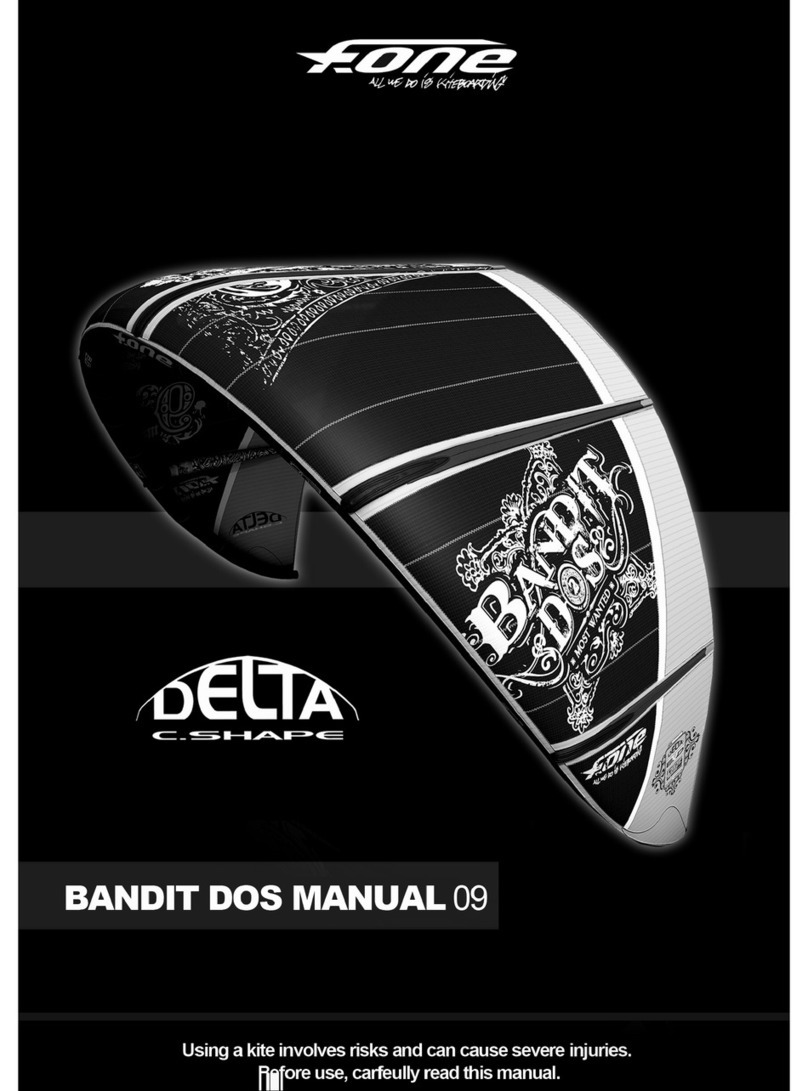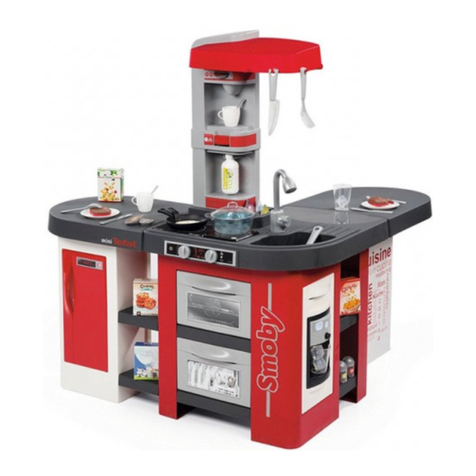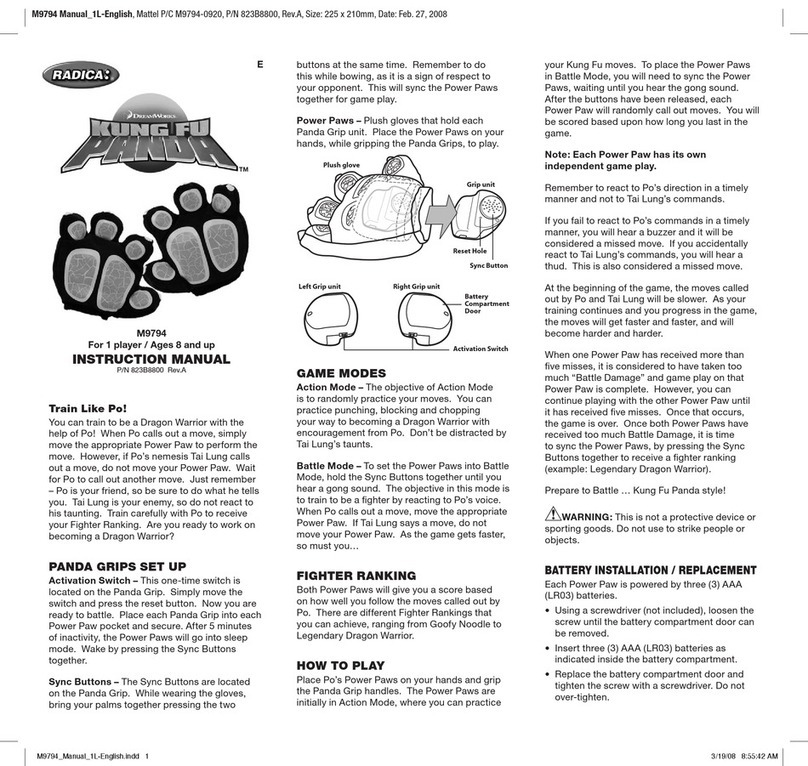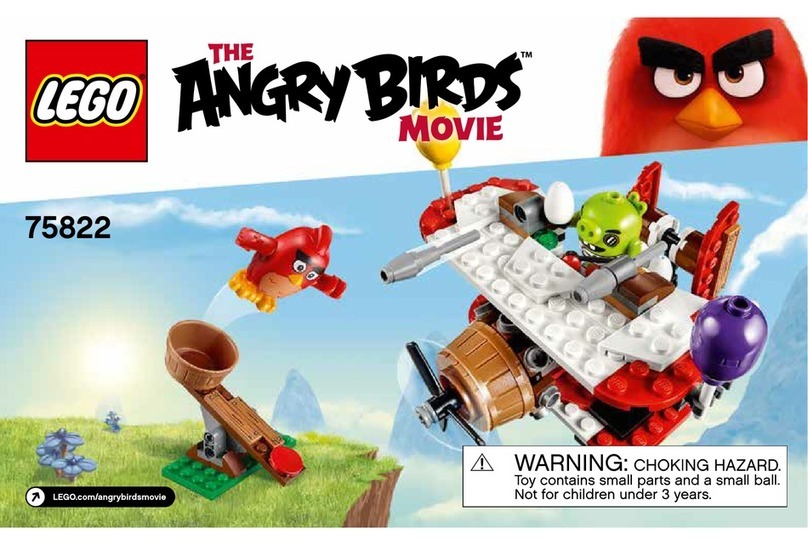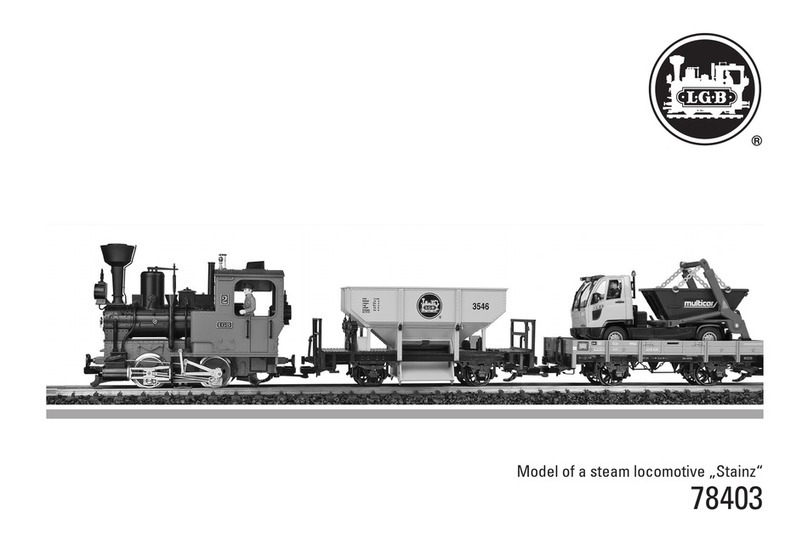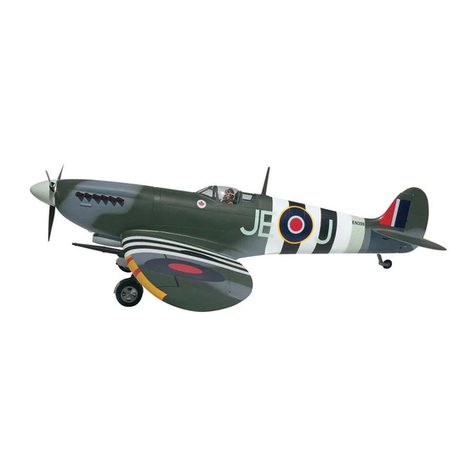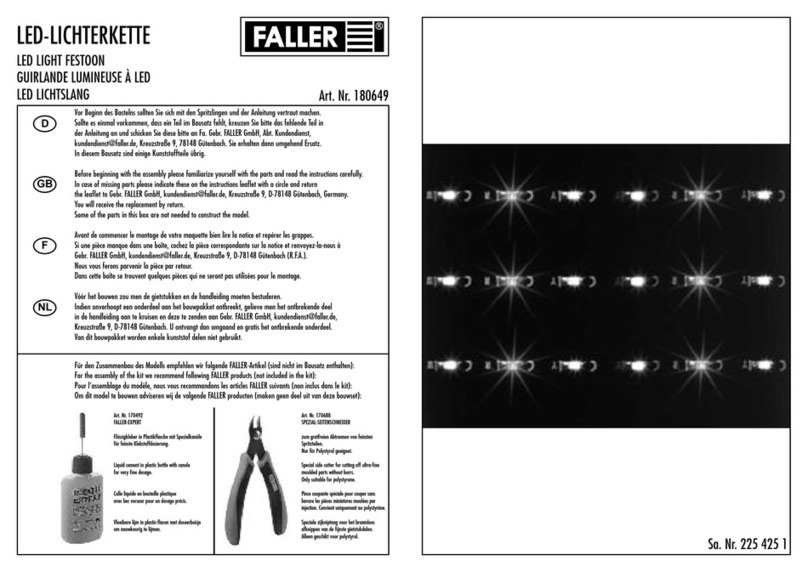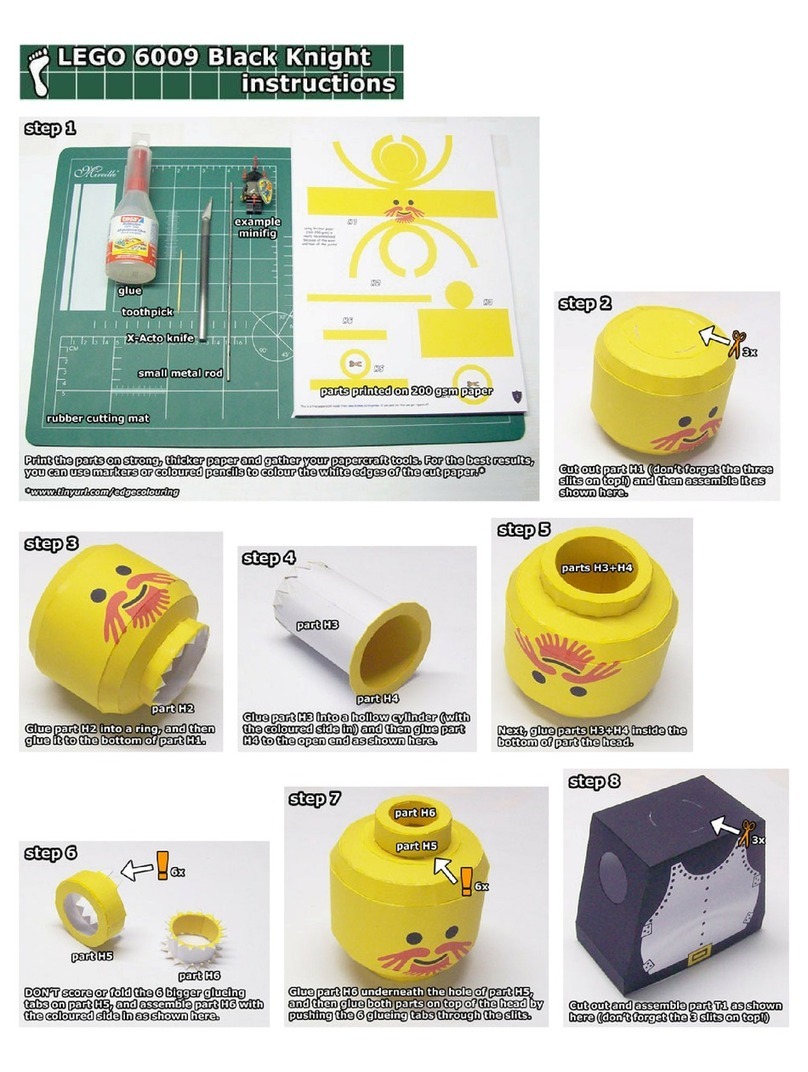Fone Kitefoil User manual

www.f-onekites.com
- 1 -
Notice d’utilisation - User Guide
KITEFOIL
La pratique de l’hydrofoil comporte certains risques et
peut causer des accidents graves.
LISEZ ATTENTIVEMENT CE MANUEL AVANT D’UTILISER
CE FOIL.
Using a kite and/or a hydrofoil involves risks and can
cause severe injuries.
CAREFULLY READ THIS MANUAL BEFORE USE.
FR
-
EN

www.f-onekites.com www.f-onekites.com
- 2 - - 3 -
L’utilisation d’un hydrofoil comporte certains
risques et peut causer des accidents graves.
C’est pourquoi il est vivement conseillé de
suivre une formation préalable dans une école
spécialisée avant toute première utilisation.
Pour trouver l’école la plus proche de chez vous,
rendez-vous sur le site www.f-onekites.com à la
rubrique schools.
AVANT D’UTILISER VOTRE FOIL, LISEZ ATTENTIVEMENT CE MANUEL ET CONSERVEZ LE
POUR UNE CONSULTATION ULTÉRIEURE.
Avant toute pratique vériez que vous disposez
d’une assurance couvrant votre responsabilité ci-
vile pour la pratique des glisses aérotractées, et
de garanties sufsantes pour les risques d’acci-
dent corporel personnel (sans tiers responsable).
La licence FFVL comprend une assurance, ren-
seignez-vous sur www.ffvl.fr.
RÈGLE N° 1: VOTRE SÉCURITÉ
RÈGLE N° 2: ÉQUIPEZ-VOUS
FR
L’équipement (casque, gilet, ...etc) contribue à votre sécurité mais les meilleures sécurités
reste la prudence et l’attention. Rappelez-vous que personne ne peut contrôler son
hydrofoil à 100%.
Ne partez jamais naviguer seul. Il est conseillé de pratiquer en présence d’une personne qui pourra en
cas d’incident prévenir des secours.
Le casque :
Le casque est conseillé pour vous protéger lors des chutes mais il vous sauvera également dans
d’autres conditions inattendues et plus particulièrement au sol lors de décollages ou d’atterrissages
qui nissent mal.
La combinaison :
Choisissez une combinaison intégrale (eau<19°) ou un shorty (eau>19°) selon la température de l’eau.
Sachez que lorsque vous avez froid, vous consommez plus d’énergie.
Le gilet de protection :
Le gilet peut faciliter le waterstart et le redécollage de l’aile. Vous serez également content de le porter
pour amortir vos mauvaises chutes. C’est aussi un véritable compagnon de galère lorsqu’il faut rentrer
à la nage.
VOICI QUELQUES RÈGLES DE SÉCURITÉ À CONNAÎTRE ET À RESPECTER :
RÈGLE N° 3: CHOISISSEZ VOTRE LIEU DE PRATIQUE
p. 3
p. 3
p. 3
p. 3
p. 4
p. 4
p. 5
p. 6
p. 6
p. 6
p. 6
p. 7
p. 7
p. 8
p. 8
p. 8
p. 8
p. 9
p. 9
p. 10
p. 11
p. 11
p. 11
p. 11
p. 12
p. 12
FRANÇAIS
ENGLISH
SOMMAIRE - TABLE OF CONTENTS
SÉCURITÉ
∙ Votre sécurité
∙ Équipez-vous
∙ Choisissez votre lieu de pratique
∙ Vériez les conditions météorologiques
∙ Respectez et aidez les autres
FAIRE CONNAISSANCE AVEC LE KITEFOIL F-ONE
MONTER / DÉMONTER LE KITEFOIL F-ONE
∙ Pour assembler le kitefoil
∙ Pour monter le kitefoil sur la planche
∙ Pour démonter le kitefoil
∙ Utiliser le kitefoil F-ONE
∙ Entretenir le kitefoil F-ONE
SAFETY
∙ Your own Safety
∙ Get set up
∙ Choose your practice spot
∙ Check the weather conditions
∙ Help out others
GET TO KNOW THE F-ONE KITEFOIL
ASSEMBLING / TAKING APART THE F-ONE KITEFOIL
∙ Assembling the kitefoil
∙ Fitting the kitefoil onto the board
∙ Taking the kitefoil appart
∙ Using the F-ONE Kitefoil
∙ Keeping the F-ONE kitefoil in great conditions
Choisissez votre spot en fonction de votre niveau :
Le choix du spot est primordial pour un apprentissage en sécurité. Le bon spot n’est pas forcé-
ment le spot où il y a le plus d’ailes. Pour le choix du plan d’eau, il est important de choisir un spot
adapté à la pratique du foil. La pratique du foil nécessite une profondeur supérieure à la pratique du
kite en twin-tip. Privilégiez un plan d’eau sans récif, dégagé, en évitant les endroits trop fréquentés.
L’orientation du vent
Ne naviguez jamais par vent off-shore si vous n’avez pas de bateau d’assistance. Vous n’êtes ja-
mais à l’abri du vent qui tombe ou d’une ligne qui casse. Par vent offshore, il est plus difcile de rentrer
à la nage, le vent et le courant vous poussant vers le large.
Il est aussi déconseillé de naviguer par vent on-shore tout particulièrement pour les débutants, le vent
vous poussant directement sur la plage. Cela va rendre votre apprentissage plus difcile: vous ne pou-
vez pas faire de longs bords si vous ne capez pas et vous arriverez très vite sur le sable. Cela sera aussi
plus risqué, à la moindre rafale ou erreur vous vous retrouverez embarqué sur le sable. Il faut donc
naviguer par vent side ou side-on, vous pourrez ainsi à loisir descendre le vent tout en étant sûr de
pouvoir rentrer à terre facilement au moindre problème.
SÉCURITÉ

www.f-onekites.com www.f-onekites.com
- 4 - - 5 -
1
5
4
5
2
3
6
89
7
RÈGLE N°5: RESPECTEZ ET AIDEZ LES AUTRES
Respectez les zones de navigation :
Le kitefoil se pratique au-delà de la bande des 300 mètres et jusqu’à un mille d’un rivage accessible.
Le kitefoil doit être pratiqué à l’intérieur de la zone des 300 mètres avec précaution et en tout cas à une
vitesse inférieure à 5 nœuds sauf dérogation accordée par la Préfecture Maritime. La pratique du kitefoil
est interdite dans les zones de baignade et plus généralement dans toute zone réservée à une autre
activité. Renseignez-vous auprès du club gestionnaire du site ou des pratiquants locaux des règles
locales spéciques.
LE KITEFOIL F-ONE SE COMPOSE DE PLUSIEURS PARTIES DISTINCTES:
ATTENTION
MISE EN GARDE Les ailes avant et arrière fonctionnent comme des plans porteurs, c’est-à-dire qu’elles créent une force
de portance au contact de l’eau qui s’écoule autour d’elles avec de la vitesse. C’est la raison pour la-
quelle les ailes reçoivent un prol spéciquement étudié.
Mât
1 Tête de mât
2 Lame
3 Pied de mât
Aile
4 Rostre
5 Lame
6 Connecteur Stabilisateur
Stabilisateur
Winglet
Vis tête fraisée
2 vis
Fuselage
Connecteur
Fuselage
Extremité inox
Vis principale
7 Tête
8 Tige
9 Filetage
La forme du prol des ailes ne doit pas être modiée, enduite ou poncée, au risque de
perturber l’équilibre et le fonctionnement du kitefoil.
ATTENTION: An de garantir l’agrément d’utilisation et les performances, le bord arrière
des ailes (bord de fuite) doit rester très n ce qui rend cette partie plus fragile aux chocs.
Lors des manipulations et de l’utilisation du kitefoil, il est également nécessaire de faire
attention à ces zones affûtées an d’éviter tout risque de blessure.
RÈGLE N°4: VÉRIFIEZ LES CONDITIONS MÉTÉOROLOGIQUES
Produit présentant des parties affûtées. Risque de blessure.
Port du casque et d’un gilet de protection fortement
recommandé.
Lors d’une chute, le kitefoil et la planche peuvent conserver
leur vitesse un certain temps avant de s’arrêter. Attention
aux risques d’impact.
L’ensemble kitefoil + planche peut dériver à une vitesse
supérieure à celle d’une planche seule. Ne pas laisser le
kitefoil dans l’eau sans attention pendant trop longtemps au
risque de le voir s’éloigner rapidement.
Le kitefoil ajoute du poids et de l’encombrement à la planche.
Lorsqu’il est immergé, le kitefoil produit une plus grande force
d’opposition à la dérive liée à la force du kite. La planche
ne glisse pas aussi facilement qu’une planche sans kitefoil.
Les manipulations dans l’eau doivent se faire de manière
douce et contrôlée. Attention aux mouvements brusques.
FR
Informez-vous sur la météo avant d’aller naviguer (téléphone, web, capitainerie):
Quelle force de vent est annoncée et quelle direction? Vous devez savoir comment la force et
la direction du vent vont évoluer au cours de la journée. Le kitefoil permet de naviguer dans des
conditions marginales, il faut donc faire attention au risque que le vent tombe complètement.
Vous ne devez pas naviguer par temps orageux.
Renseignez-vous également sur les horaires des marées et les zones de courants forts.
Aidez les autres :
Soyez toujours attentifs aux autres pratiquants, n’hésitez pas à proposer votre aide ou encore allez aider
un pratiquant en difculté.
Respectez le public :
Mettez en garde les spectateurs du danger potentiel à rester sous le vent des pratiquants. Ne conez
pas votre matériel à une personne qui n’a jamais pratiqué.
FAIRE CONNAISSANCE AVEC LE KITEFOIL F-ONE
10
10
11
11
12
12
12
13
13
14
14
15
15

www.f-onekites.com www.f-onekites.com
- 6 - - 7 -
LE KITEFOIL F-ONE BÉNÉFICIE DU SYSTÈME D’ASSEMBLAGE UNIQUE ET BREVETÉ:
LE «FAST CONNECTION DEVICE». LA VIS PRINCIPALE ASSEMBLE TROIS PARTIES DES
KITEFOILS F-ONE.
Mise à l’eau, retour à terre:
• Marcher dans l’eau en gardant la planche sous le bras (planche couchée sur le côté).
• Avancer jusqu’à atteindre une profondeur supérieure à la hauteur du foil. Attention, une marge de
sécurité est nécessaire car la planche et le foil s’enfoncent lorsque le rider monte sur la planche. An
d’éliminer tout risque d’impact avec un haut fond, il est fortement recommandé de s’éloigner du bord
en nage tractée en gardant la planche et le foil sur la tranche jusqu’à atteindre une zone ou la profon-
deur de l’eau est sufsante et sécurisante.
• Lors du retour à terre, il est nécessaire de descendre de la planche à la même distance du bord qui a
été nécessaire pour la mise à l’eau, puis de marcher ou d’utiliser la nage tractée pour se rapprocher du
bord. Veiller dans ces phases à garder la planche et le foil sous le bras dans la même position couchée.
POUR ASSEMBLER LE KITEFOIL :
POUR MONTER LE KITEFOIL SUR LA PLANCHE :
POUR DÉMONTER LE KITEFOIL :
ENTRETENIR LE KITEFOIL F-ONE :
UTILISER LE KITEFOIL F-ONE :
• Poser la planche à l’envers (carène vers le haut)
• Insérer le talon du foil dans le boitier KF BOX
prévu dans la carène
• Basculer la planche sur la tranche avec précaution
• Visser les deux vis M6 à l’aide de la même clef
plate #10 sans oublier de placer les rondelles
de 18mm.
• Visser les deux vis pour xer le stabilisateur au
fuselage.
• Placer la rondelle de 12mm sur la vis principale
• Insérer la vis principale à travers l’aile avant
• Emboiter le fuselage dans l’arrière du pied de mât
• Emboiter l’aile avant avec la vis dans l’avant
du pied de mât
• Visser à l’aide d’une clef plate #10
• Il faut serrer fermement jusqu’à obtenir un
ensemble monobloc sans trop forcer au risque
d’abimer le kitefoil.
• Placer l’ensemble kitefoil + planche assemblé
à l’envers
• Dévisser la vis principale en laissant le mât
connecté à la planche
• Retirer la vis, puis retirer l’aile avant et le fuselage
du pied de mât *
• Basculer la planche sur la tranche pour dévisser
les deux vis M6 du mât
• Retirer le mât de la planche.
DE PART SES DIMENSIONS ET SON POIDS, LE KITEFOIL CHANGE TOTALEMENT LE
COMPORTEMENT DE LA PLANCHE SUR TERRE COMME EN MER.
Manipulation à terre:
Toujours poser le foil assemblé sur la tranche
comme ceci:
Pour la mise à l’eau, veiller à porter le foil sur le
côté, saisir l’ensemble en portant la planche sous
le bras juste devant le boitier KF BOX, comme ceci:
Après chaque utilisation, veiller à toujours:
• Démonter l’aile avant et le fuselage arrière du mât.
• Nettoyer et rincer l’ensemble des pièces composant le kitefoil avant de les ranger.
• Protéger les pièces en les rangeant dans l’emballage d’origine ou une autre protection adaptée.
Veillez à garder un aspect de surface propre et lisse. Le kitefoil fonctionne en équilibre dynamique et
l’écoulement autour des plans porteurs et du mât peut être sensible aux imperfections. Des risques de
décrochement déséquilibrant l’utilisateur et de chutes soudaines sont possibles si l’état de surface des
différentes parties est trop endommagé.
En cas d’aspérités supercielles après un choc, combler avec une résine ou un mastique époxy et poncer
jusqu’à retrouver un état de surface propre et lisse. Il est recommandé de coner la réparation à un professionnel.
FR
• Pour un équilibre idéal placer l’insert arrière du
strap avant à 370mm de la vis avant du foil.
*Pour plus de facilité, saisir l’aile avant aux
extrémités et alterner de petits mouve-
ments secs et verticaux (gauche/droite).
Appliquer les mêmes mouvements verti-
caux pour le stabilisateur en saisissant
l’arrière du fuselage.
Ne pas laisser le kitefoil assemblé avec la
planche, posé à l’endroit ou à l’envers. Il risquerait
de basculer et de s’endommager.
370 mm
MONTER / DÉMONTER LE KITEFOIL F-ONE

www.f-onekites.com www.f-onekites.com
- 8 - - 9 -
Using a hydrofoil involves inherent risks and
can cause severe injuries or, sometimes fatal,
accidents if misused. F-ONE therefore strongly
recommends to follow kiting lessons in a spe-
cialized school before using a hydrofoil for the
rst time.
To nd your nearest school, please check online
on the www.f-onekites.com website under the tab
« schools». When using a hydrofoil, you agree to
READ CAREFULLY THIS MANUAL BEFORE USING YOUR KITE AND KEEP IT STORED FOR
FUTURE READING
take full responsibility for your own safety and those
of others, which includes informing subsequent
users/owners of your equipment of the risks and
responsibilities involved. Before practicing, make
sure that you are properly covered by an insurance
for any damage or injuries caused to third parties
while practicing kiting sports. Please refer to your
national kitesurng body or federation to get more
information on insurance and responsibilities.
RULE N°1: YOUR OWN SAFETY
RULE N°2: GET SET UP
Specialized equipment contributes to your own safety but constant care and caution
remains the best way to avoid any problem. Please keep in mind that wind and weather
can be unpredictable and that no-one can be in full control of the hydrofoil all the time.
You should never go riding alone. It is strongly recommended to practice in the company of other users
who could eventually call for assistance or help in case of emergency.
Helmet :
It is strongly recommended to wear a helmet to protect you in case of a fall or any other unexpected
situations and especially when launching and landing the kite from the ground.
Wetsuit :
Choose a full-length wetsuit (water T° <19°C) or a shorty (water T°>19°C) depending on the water tem-
perature. Be aware that you will use more energy when you are cold.
Impact vest :
The impact vest can help you with the waterstart and the relaunch of your kite. It might also be welco-
me when falling hard and will become your new best-mate if you ever have to swim back to the shore.
A FEW SAFETY TIPS TO KNOW AND FOLLOW:
RULE N° 3: CHOOSE YOUR PRACTICE SPOT
RULE N° 5: RESPECT AND HELP OUT OTHERS
Check with the local weather forecast, (radio, web, harbor crew).
How strong are the winds and from which direction? You must know how the speed of the wind and
the direction are going to evolve during the day. The hydrofoil enables you to ride even in marginal
conditions, keep in mind the wind can quickly die completely.
You should not ride during stormy weather.
Also check on the tides schedule and the areas for rip currents.
WARNING
RULE N° 4: CHECK THE WEATHER CONDITIONS
Product presenting sharp areas - Risk of injuries
Protection helmet and impact vest are strongly
recommended during use.
When falling, the board and kitefoil can keep their pace
for some time before stopping. Beware of impacts.
The board and kitefoil can drift away at higher
speed than a normal single board. Do not leave
your kitefoil unattended in the water for too long or
it could drift far away from you rapidly.
The kitefoil modies the weight and size of the board.
When immerged, the kitefoil generates more force
opposing the drifting force of the kite. The board
does not slide on the water the same way as a single
board. Handling movements should be soft and
controlled. Beware any hasty or abrupt movement.
EN
Observe local laws and regulations regarding kitesurf and the usage area.
Choose your spot according to your level :
The choice of a good spot is a prerogative for a safe learning. The best spot is not necessarily the spot
where you nd the most kites. To choose your place of practice, it is important to select a spot suited
to the practice of hydrofoil. Using a hydrofoil requires a greater water depth than the other kiteboarding
practices. Favor a spot without reefs or shoals, and avoid overcrowded areas.
Wind direction :
Never ride in strong offshore wind. The wind can die at any moment or a line can break. In offshore wind
it is harder to swim back to shore, the wind and the current pushing away from the beach.
It is not recommended to ride when the wind is on-shore especially for beginners as the wind pushes
directly onto the beach. This will make your learning harder: you will not be able to do good runs and
go up wind, and you will end up on the sand very quickly. This will also be more risky as any gust could
send you onto the sand. Therefore always ride while the wind is side or side-on, this will let you go
downwind while keeping a safe position in case of an emergency.
Help out others :
Always keep an eye on your surroundings, and pay attention to others. Do not hesitate to help out or
go after a struggling kitesurfer.
Respect bystanders :
Inform the spectators of the power of the kite and of the potential risk by staying downwind from a
kite surfer.
Do not lend your equipment to a none kite surfer.
SAFETY

www.f-onekites.com www.f-onekites.com
- 10 - - 11 -
THE F-ONE KITEFOIL IS MADE SEVERAL DISTINCT PARTS:
The front and rear wings work as lifting devices, which means they can create a lifting force from the
ow of water that travels across them at speed. This is the reason why they are built with a specic
sectional prole:
The shape of the wings’ profile shall not be modified, filled and sanded. Doing so would alter the
balance and prevent the correct operation of the kitefoil.
WARNING: In order to guarantee the correct behavior and performances of the kite-
foil, the rear edge (trailing edge) of the wings must remain very thin, thereby making
this part more fragile in case of impacts. During handling and use of the kitefoil, the
user should be particularly cautious with these sharp areas in order to avoid any risk
of injury.
THE F-ONE KITEFOIL BENEFITS OF OUR UNIQUE AND PATENTED ASSEMBLY SYSTEM :
THE “FAST CONNECTION DEVICE”. TO ASSEMBLE THE F-ONE KITEFOIL, THE MAIN ROD
RUNS THROUGH AND TIGHTENS THREE PARTS OF THE FOIL.
ASSEMBLING THE KITEFOIL :
FITTING THE KITEFOIL ONTO THE BOARD :
TAKING THE KITEFOIL APPART :
• Place the board face down on the ground (bot-
tom up)
• Insert the head of the mast into the KF BOX in-
sert built into the board
• Hinge the board on its side with care
• Insert and tighten the two M6 bolts using the
same #10 spanner and do not forget to place
the 18mm washers
• Place and tighten the two bolts to fasten the
stabilizer onto the fuselage.
• Place the 12 mm washer on the main rod
• Insert the main rod through the front wing
• Fit the fuselage into the rear of the mast foot
• Fit the front wing with the rod into the front of
the mast foot
• Screw the rod using a #10 spanner
• Tighten the rod firmly until reaching a solid
assembly, do not over tighten as this could
damage the kitefoil
• Keep the kitefoil fastened to the board and
place it upside down on the ground
• Unscrew the main rod with the mast still fastened
to the board
• Take away the rod, then the front wing and
fuselage from the mast foot *
• Hinge the board back on its side to unscrew
the top mast bolts
• Take away the mast from the board
• To achieve the best balance, set the rear insert
of your front footstrap at 370mm from the front
bolt of the foil.
*For more ease, hold the front wing by its tips
and alternate some small but sharp vertical
movements (left/right) Apply the same vertical
movements for the stabilizer by holding it at
the back of the fuselage.
370 mm
EN
GET TO KNOW THE F-ONE KITEFOIL ASSEMBLING / TAKING APART THE F-ONE KITEFOIL
1
5
4
5
2
3
6
8
9
7
Mast
1 Head
2Blade
3 Mast foot
Wing
4 Bulb
5 Blade
6 Connector Stabilizer
Stabilizer
Winglet
Tapered Screws
2 screws
Fuselage
Connector
Fuselage
Stainless Steel Tail
Main rod
7 Head
8 Rod
9 Thread
10
10
11
11
12
12
12
13
13
14
14
15
15

www.f-onekites.com
- 12 -
HandlingIn the water:
• Walk into the water while keeping your board and foil under your arm (board on its side)
• Go deeper into the water until reaching a water patch deep enough for the size of the foil. Warning: a
safety margin is required as the board and foil will sink to some degree when the rider gets onto the
board. To prevent any risk of collision with a reef or a shoal, it is strongly recommended to get dragged
away from the shore using the kite while keeping the board and foil and its side, until reaching deep
enough water.
• When heading back to the shore, it is necessary to get down from the board at the same distance from
the shore that had been required to start safely. Again, it is recommended to walk or use the kite to get
dragged back to the shore. During these phases, the board must be kept on its side under your arm
KEEPING THE F-ONE KITEFOIL IN GREAT CONDITIONS :
Following every use, make sure you always:
• Take apart the front wing and rear fuselage from the mast.
• Clean and rinse all the parts of the kitefoil before storing them.
• Protect the parts by storing them in their original packaging or using another appropriate protection.
Make sure the surface of the blades remain smooth and clean. The kitefoil works using a dynamic equilibrium
and the ow around the wings can be very sensible to local roughness. Sudden stalling can happen if the surface
condition of the several parts is compromised. Stalling the foil can unsettle the rider and result in abrupt falls.
If local bumps or troughs appear following an impact, ll with epoxy resin or primer and sand until the local sur-
face is smooth and clean again. It is strongly recommended to let a professional handle these kinds of repairs.
USING THE F-ONE KITEFOIL :
WITH ITS ADDED DIMENSIONS AND WEIGHT, THE KITEFOIL SIGNIFICANTLY CHANGES
THE BEHAVIOR OF THE BOARD BOTH ON SHORE AND IN THE WATER.
Handling on shore:
When left on the ground, the F-ONE kitefoil should
always be laid on its side, like so: When heading for the water, the kitefoil should always
be carried on its side with the board under your arm.
Hold the board just forward of the KF BOX, like so :
Never leave the kitefoil (assembled with the board)
standing up or upside down. It can easily fall on its
side and get damaged.
Table of contents
Languages:
Other Fone Toy manuals
Popular Toy manuals by other brands

Hasbro
Hasbro Battle Blade Starscream 82431 instructions
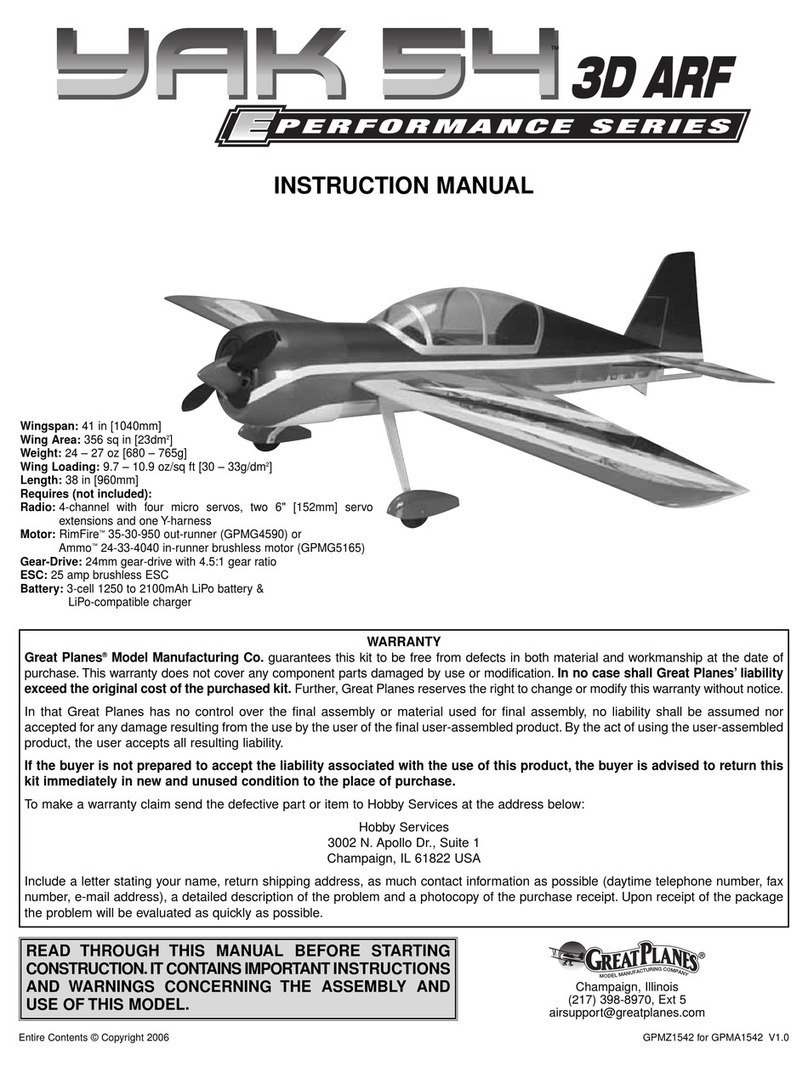
GREAT PLANES
GREAT PLANES Yak 54 36 ARF instruction manual

Disney
Disney INFINITY 8033114 quick start guide
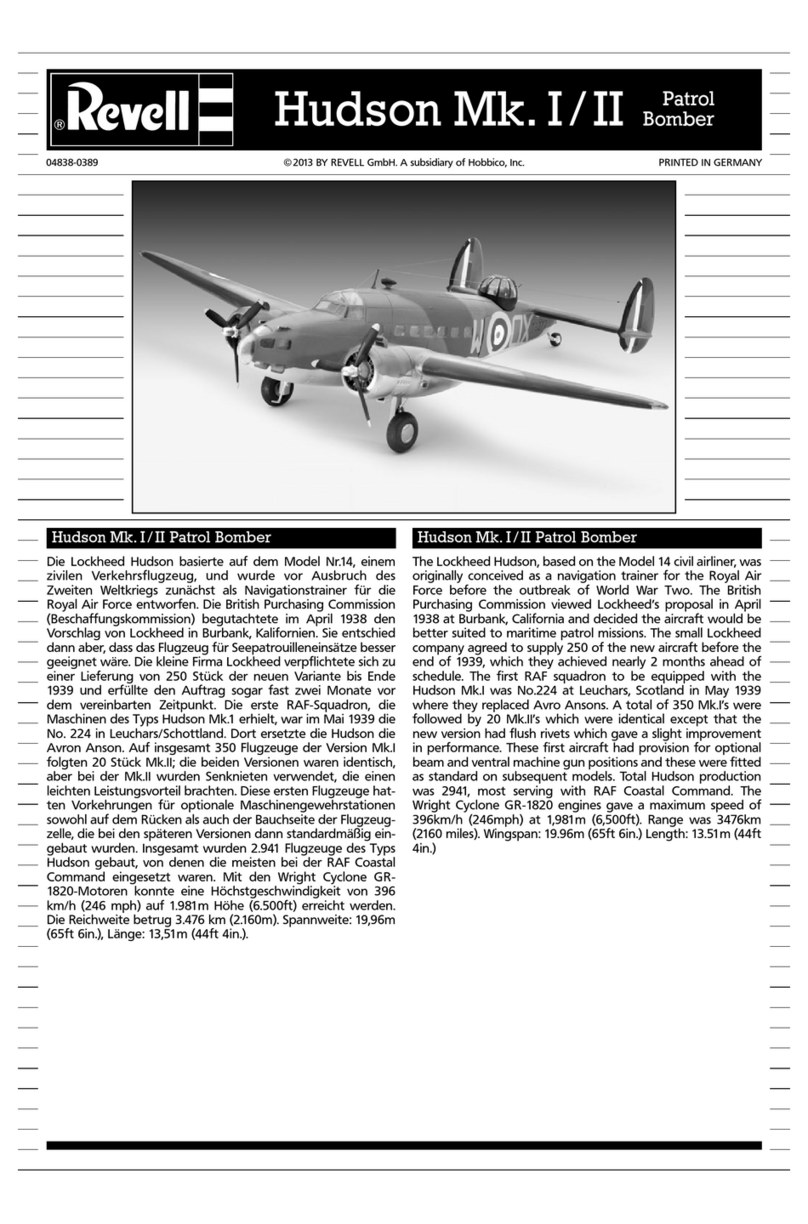
REVELL
REVELL Hudson Mk. I/II Patrol Bomber Assembly manual
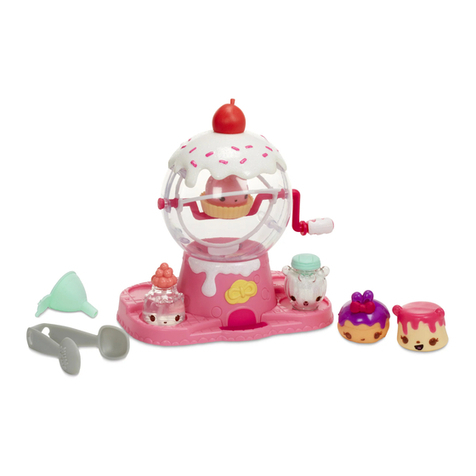
MGA Entertainment
MGA Entertainment NUM NOMS Shimmer Playset 552024 instructions
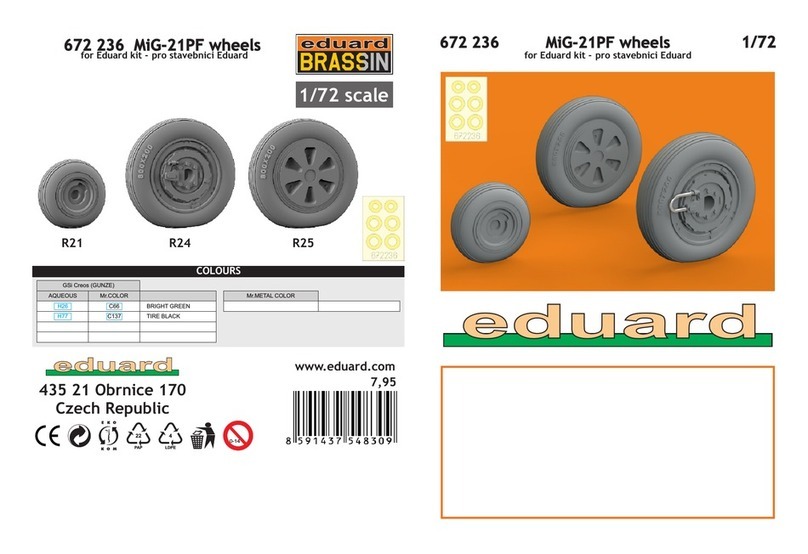
Eduard
Eduard MiG-21PF manual
